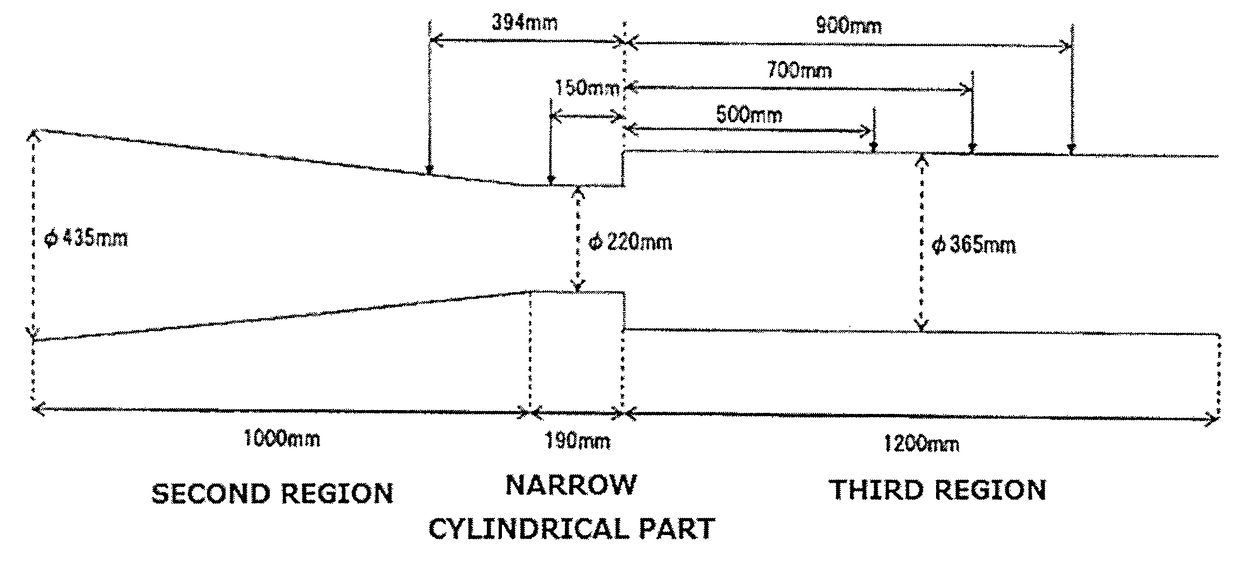Rubber composition and tire using the same
a technology of composition and rubber, applied in the field of rubber composition, can solve the problems of reducing the fracture strength and abrasion resistance of rubber composition, difficult to obtain, and reducing the blending amount of carbon black, etc., and achieves excellent wet grip performance and abrasion resistance, small rolling resistance, and low fuel consumption
- Summary
- Abstract
- Description
- Claims
- Application Information
AI Technical Summary
Benefits of technology
Problems solved by technology
Method used
Image
Examples
examples
[0041]The present invention shall be explained below in detail with reference to examples, but the present invention shall by no means be restricted to the following examples.
production examples 1 to 6
Production of Carbon Blacks CB1 to 6
[0042]A carbon black production furnace in which a first region (not illustrated): a fuel introducing part (an inside diameter: 680 mm, a length: 900 mm), a second region: a raw material introducing part (an upper stream end inside diameter: 435 mm, a lower stream end inside diameter: 220 mm, a length: 1000 mm, a taper angle: 6.1°), a narrow cylindrical part (an inside diameter: 220 mm, a length: 190 mm), and a third region: a reaction continuation and cooling chamber equipped with a quenching hydraulic spraying equipment for reaction termination (an inside diameter: 365 mm, a length: 1200 mm) were arranged from an upper stream shown in FIG. 1 was used, and a heavy oil shown in Table 1 was used as a raw material oil to produce carbon blacks of CB1 to 6 under operating conditions shown in Table 2.
[0043]
TABLE 1Specific gravity (JIS K2249) (15 / 4° C.)1.0833Kinetic viscosity (JIS K2283) (mm2 / s at 50° C.)120.5Moisture (JIS K2275) (%)0.1Residual carbon (...
production example 7
Production of Modified Butadiene Rubber (Modified BR)
[0045]A pressure proof vessel of 800 mL which was dried and replaced with nitrogen gas was charged with a cyclohexane solution (20% by mass) of 1,3-butadiene 60 g, and 2,2-ditetrahydrofurylpropane 0.70 mmol and further charged with n-butyllithium (BuLi) 0.70 mmol, and then they were subjected to polymerization reaction for 1.5 hour in a warm water bath of 50° C. The polymerization conversion rate was almost 100%.
[0046]Then, tin tetrachloride (SnCl4) 0.2 mmol was added to the polymerization system to carry out modification reaction for 30 minutes. Lastly, an isopropanol 5 mass % solution of 2,6-di-t-butyl-p-cresol (BHT) 2 mL was added to the polymerization reaction system to terminate the reaction. Thereafter, the reaction product was subjected to vacuum drying to obtain modified BR.
[0047]The copolymer thus obtained had a weight average molecular weight of 100,000.
[0048]Measuring the properties of the carbon blacks CB used in the e...
PUM
| Property | Measurement | Unit |
|---|---|---|
| nitrogen adsorption specific surface area | aaaaa | aaaaa |
| adsorption specific surface area | aaaaa | aaaaa |
| temperature | aaaaa | aaaaa |
Abstract
Description
Claims
Application Information
 Login to View More
Login to View More - R&D
- Intellectual Property
- Life Sciences
- Materials
- Tech Scout
- Unparalleled Data Quality
- Higher Quality Content
- 60% Fewer Hallucinations
Browse by: Latest US Patents, China's latest patents, Technical Efficacy Thesaurus, Application Domain, Technology Topic, Popular Technical Reports.
© 2025 PatSnap. All rights reserved.Legal|Privacy policy|Modern Slavery Act Transparency Statement|Sitemap|About US| Contact US: help@patsnap.com


